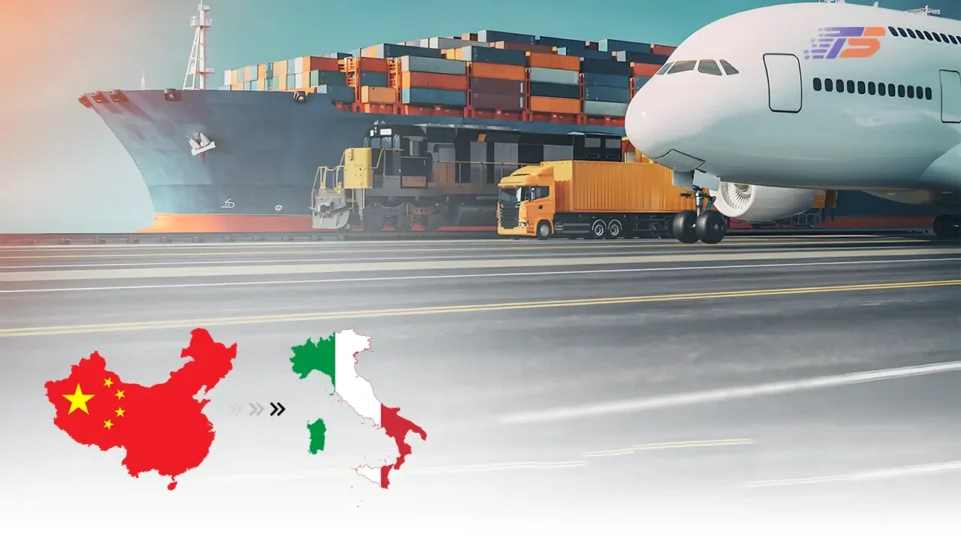Shipping goods from China to Italy is more than just choosing a logistics provider—it’s a strategic decision that directly affects costs and delivery times. In 2024, trade between the two nations reached around €62 billion, with Italy exporting €16.6 billion to China. Efficient transport relies on well-established Shipping Routes connecting major Chinese ports with Italian hubs such as Genoa, Trieste, and Venice.
For businesses planning broader trade, understanding Shipping from China to Europe is essential, as Italy serves as a key entry point for goods destined for the wider European market. Costs vary depending on shipment size, cargo type, and urgency. This guide summarizes the mainshipping methods , helping you plan efficiently and select the best solution for your business.
August 2025 Shipping Update: China → Italy
Costs
The China to Italy shipping market in August 2025 experienced notable fluctuations, particularly in air and sea freight.
- Air Freight: ~$3.50/kg for shipments over 1,000 kg to major Italian airports.
- Sea Freight (20′ FCL): $2,650 to Genoa.
- Sea Freight (40′ FCL): $3,300 to Genoa.
- Rail Freight (40′ HQ): $8,400 per container.
- Rail LCL: ~$225 per cubic meter.
Delivery Times
| Mode | Route | Cost Estimate | Transit Time | Best For |
|---|---|---|---|---|
| Air Freight | China → Milan / Rome / Venice | ~$4.50/kg (1,000kg+) | 4–7 days | High-value, urgent, or time-sensitive shipments |
| Sea Freight (FCL) | China → Genoa / La Spezia / Trieste | $1,200 (20′) · $1,400 (40′) | 25–40 days | Bulk cargo, cost-efficient shipments |
| Sea Freight (LCL) | China → Genoa / La Spezia / Trieste | $80–$160 per CBM | 28–42 days | Smaller shipments, consolidated cargo |
| Rail Freight (FCL/LCL) | China → Milan / Turin | $190–$260 per CBM | 18–25 days | Medium shipments, balance of cost and speed |
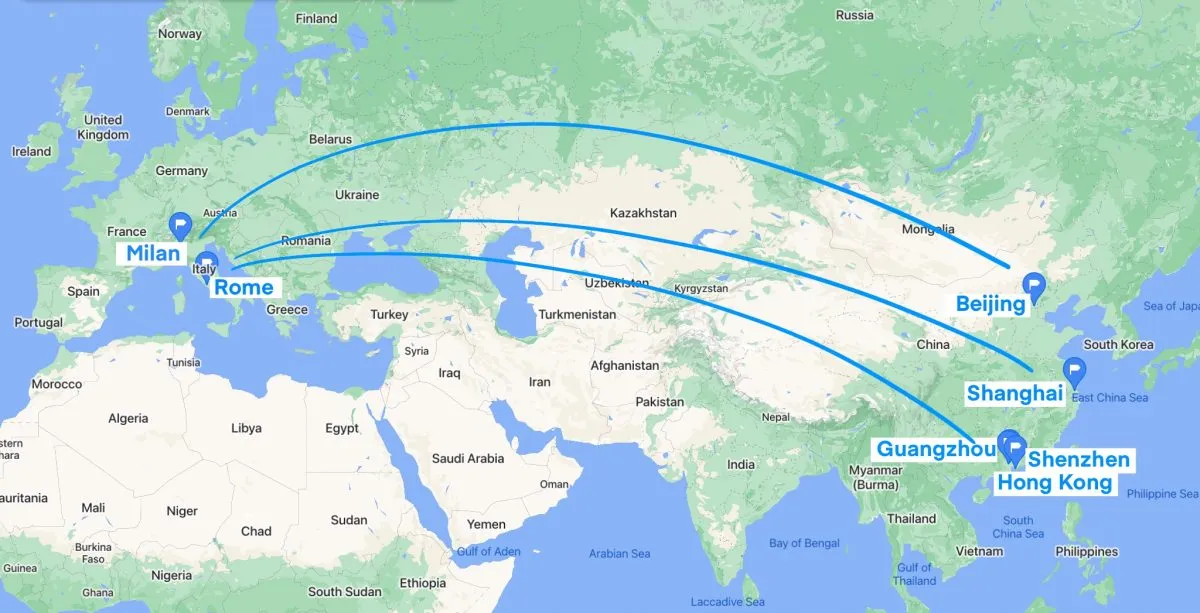
Shipping Options from China to Italy
When shipping goods from China to Italy, the key elements that shape both cost and delivery time include the transport mode, the nature of the cargo, and how quickly the shipment is required.
| Shipping Mode | Transit Time (Port/Airport to Port/Airport) | Best For |
|---|---|---|
| Express Courier (DHL/UPS/FedEx) | 3–5 days | Urgent parcels, product samples, lightweight or high-value goods |
| Air Freight | 6–9 days | Medium-sized shipments, seasonal stock, urgent B2B deliveries |
| Rail Freight (via Europe) | 18–25 days | Medium-to-large shipments requiring faster transit than sea freight |
| Sea Freight (FCL/LCL) | 28–36 days | Bulk cargo, heavy goods, flexible delivery timelines |
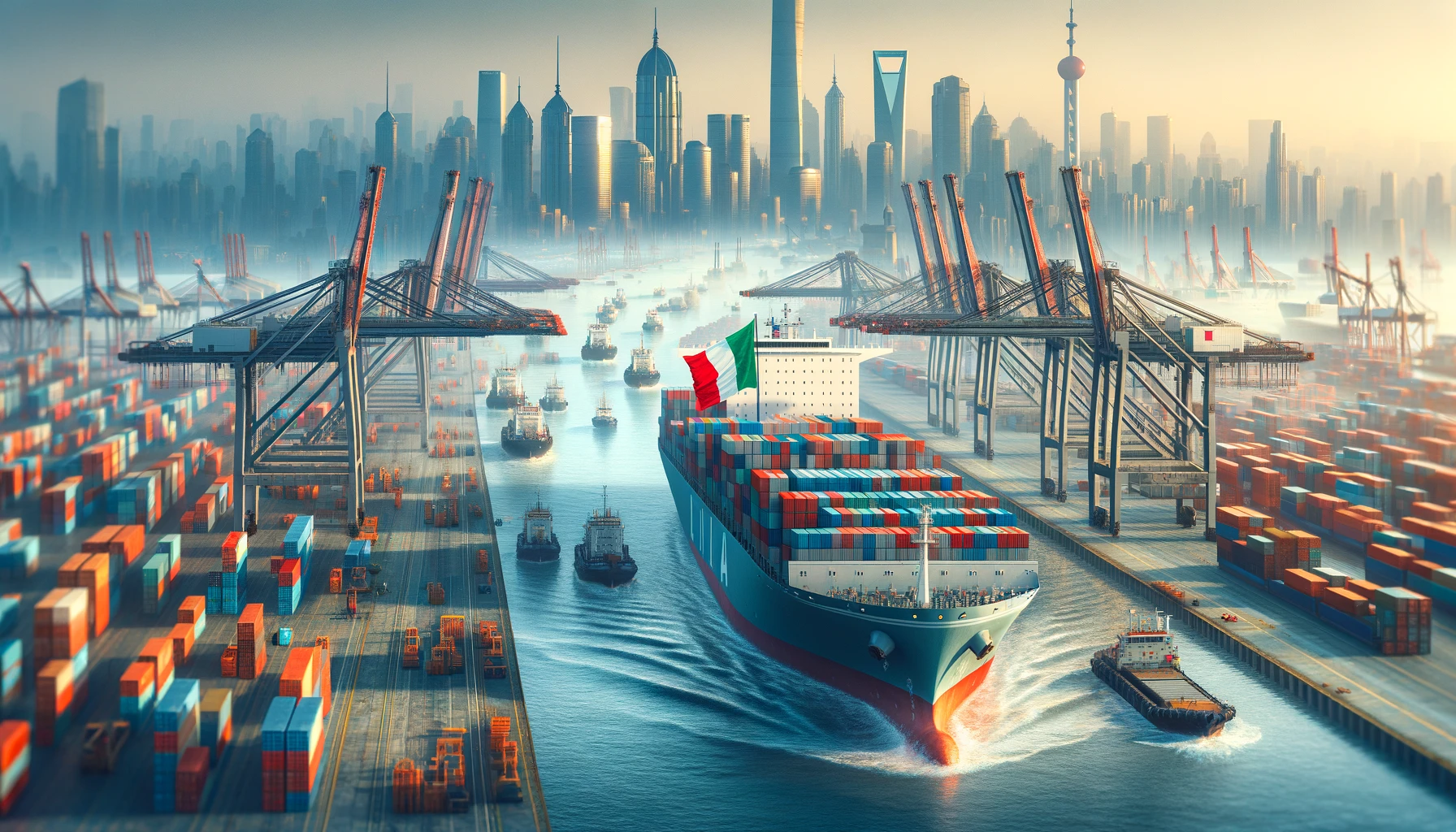
Container Types for Ocean Freight from China to Italy
Shipping from China to Italy is both reliable and cost-effective, with direct access to major ports such as Genoa, Trieste, and Venice. Choosing the right option between LCL for smaller loads and FCL for full shipments helps reduce costs, streamline customs clearance, and ensure timely delivery to your destination.
Here’s a quick guide to container sizes and their most suitable cargo.
| Container Type | Internal Dimensions (L × W × H) | Max Volume (CBM) | Max Payload (Tons) | Best Use Case |
|---|---|---|---|---|
| 20 ft Standard (TEU) | 5.9 m × 2.35 m × 2.39 m | 33 – 37 CBM | ~28 tons | Ideal for heavy cargo (machinery, metals, tiles) where weight matters more than space. |
| 40 ft Standard (FEU) | 12.03 m × 2.35 m × 2.39 m | 67 – 76 CBM | ~28 tons | Large-volume shipments without special height needs (electronics, consumer goods, packaged cargo). |
| 40 ft High Cube (HC) | 12.03 m × 2.35 m × 2.69 m | 76 – 86 CBM | ~28 tons | Light but bulky goods (textiles, furniture, plastic products, packaging foam). |
| 45 ft High Cube | 13.56 m × 2.35 m × 2.69 m | 85 – 90 CBM | ~27 tons | Oversized or extra-volume cargo, cost-efficient for high cubic loads. |
| LCL (Less than Container Load) | Shared container space | 1 – 25 CBM | Based on booking | Best for SMEs, irregular shipments, or samples – pay only for the space you use. |
| Reefer Container (20/40 ft) | 20 ft: 5.4 m × 2.26 m × 2.25 m 40 ft: 11.5 m × 2.26 m × 2.25 m | 28 – 67 CBM | ~27 tons | Temperature-sensitive goods like food, pharmaceuticals, and chemicals. |
| Open Top (20/40 ft) | Same length & width as standard | 32 – 65 CBM | ~28 tons | For oversized cargo loaded by crane (steel pipes, heavy machinery). |
| Flat Rack (20/40 ft) | 20 ft: 5.9 m × 2.44 m × 2.59 m 40 ft: 12.1 m × 2.44 m × 2.59 m | Flexible | ~28 – 40 tons | Ideal for out-of-gauge cargo (boats, construction machinery, oversized equipment). |
Efficient Door-to-Door Delivery to Italy
Simplify your supply chain with Door-to-Door shipping from China to Italy. Your goods are collected directly from suppliers, cleared through customs, and transported via sea, air, rail, or express freight straight to your warehouse or doorstep. With real-time tracking, 24/7 support, and reliable delivery to major Italian cities such as Genoa, Milan, Venice, and Trieste, you enjoy a seamless, transparent, and stress-free shipping experience.
Benefits of Door-to-Door Shipping
Looking to simplify and secure your shipments from China to Italy? Door-to-door services streamline the entire logistics process while offering multiple operational and financial benefits for your business:
- Integrated Management: From pickup in China to delivery in Italy, all steps are coordinated by a single provider, eliminating the need for multiple intermediaries.
- Reduced Risk of Damage: Fewer handling steps mean lower chances of goods being damaged or lost, especially for fragile or high-value items.
- Faster Delivery Times: Optimized routes and direct shipments reduce common delays, ensuring your goods arrive on schedule.
- Complete Transparency: Real-time tracking and detailed reporting let you monitor the status of your shipment at every stage.
- Lower Hidden Costs: By minimizing extra handling and errors, unnecessary shipping expenses are reduced, making budgeting more predictable.
- Greater Flexibility: Sea, air, rail, or express shipping can be combined to match your cargo volume, timing, and budget requirements.
- 24/7 Customer Support: TopShipping provides around-the-clock assistance for our door-to-door services, ensuring any issues are resolved quickly and your shipments stay on track.
This approach is ideal for businesses seeking fast, safe, and cost-effective shipping, significantly improving the overall logistics experience.
Amazon FBA Shipping Italy
Expanding on Amazon Italy? Let us take the logistics off your plate. We ensure your products land at fulfillment centers in Milan, Rome, and Bologna perfectly packaged, labeled, and FBA-ready.
With seamless handling from start to finish, fast delivery, and total compliance, you can focus on growing your brand, boosting sales, and reaching Italian shoppers with confidence.
Express Shipping from China to Italy
Express Shipping from China to Italy offers the fastest and most reliable way to move goods, typically delivering within 4–7 days. Ideal for high-value, time-sensitive, or eCommerce shipments, it provides door-to-door service, real-time tracking, and simplified customs clearance for hassle-free delivery.
Benefits of Express Shipping from China to Italy
- Fast Delivery: Typically 4–7 days, ideal for urgent shipments.
- Reliable Tracking: Real-time updates from departure to delivery.
- Minimal Handling: Reduces risk of damage or loss.
- Hassle-Free Customs: Carriers often assist with clearance.
- Convenient Door-to-Door Service: Direct delivery to warehouses or clients.
Use Cases
- High-value electronics or luxury goods.
- Time-sensitive business samples or prototypes.
- E-commerce parcels for fast customer fulfillment.
- Critical spare parts or machinery for industrial clients.
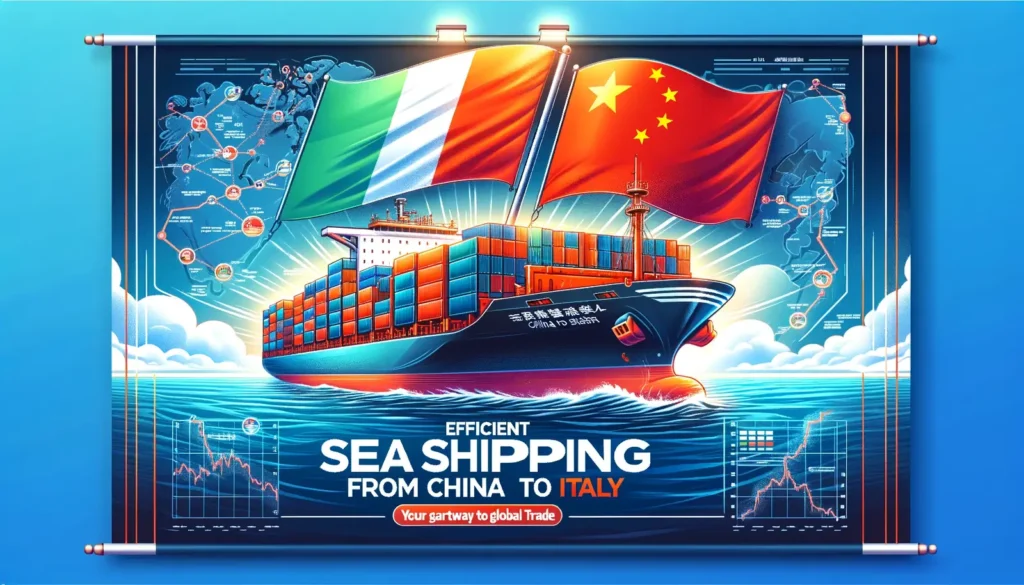
Shipping from China to Italy Transit Time
Transporting goods from China to Italy isn’t only about miles—it’s about selecting the shipping method that suits your business. Ocean, air, rail, or express options all differ in transit duration, customs procedures, and delivery efficiency. For B2B importers, knowing these timelines is essential for inventory planning, cash flow management, and ensuring client satisfaction.
Here’s a clear guide to estimated door-to-door transit times for each option, along with which shipments they are best suited for.
| Shipping Method | Transit Time (Port/Airport to Port/Airport) | Customs & Handling | Total Estimated Delivery Time (Door-to-Door) | Best Suited For |
|---|---|---|---|---|
| Express Courier (DHL/FedEx/UPS) | 2–5 days | 1–2 days | 3–7 days | Urgent parcels, samples, eCommerce shipments |
| Air Freight (Standard) | 5–8 days | 2–3 days | 7–11 days | Medium-weight shipments, time-sensitive B2B cargo |
| Sea Freight (LCL) | 20–25 days | 3–5 days | 23–30 days | Small to medium shipments, cost-effective option |
| Sea Freight (FCL) | 18–23 days | 3–5 days | 21–28 days | Large shipments, full container loads |
| Rail Freight (FCL/LCL) | 15–22 days | 2–3 days | 17–25 days | Eco-friendly, faster alternative to sea freight |
Transit Time Factors and Solutions
Shipping goods from China to Italy involves multiple factors that can extend delivery times. Understanding these challenges and planning ahead helps businesses avoid costly delays. Here are the key factors and solutions:
- Weather: Storms or heavy snow may slow sea and air shipments.
- Factory Closures: Holidays like Chinese New Year affect production.
- Cargo Type: Fragile, oversized, or hazardous items need special handling.
- Port Congestion: Busy ports like Genoa, Trieste, or Livorno can delay unloading.
- Transportation Choice: Wrong mode or route increases transit time.
- Regulatory Changes: Tariffs or policy shifts can disrupt schedules.
- Customs Delays: Incomplete documentation may trigger inspections.
- Logistics Coordination: Poor syncing between carriers and warehouses causes bottlenecks.
By addressing these factors proactively, businesses can reduce delays, optimize costs, and ensure timely deliveries from China to Italy, keeping operations smooth and customers satisfied.
Holiday & Peak Season Considerations for Shipping from China to Italy
Planning to ship goods from China to Italy? Book early! Chinese holidays like the New Year can slow down production, while peak seasons in Italy—such as Christmas and summer sales—can create port congestion and customs delays. Secure your shipment by reserving space in advance, consider faster or alternative routes, and ensure your deliveries arrive on time—smooth, stress-free, and hassle-free.
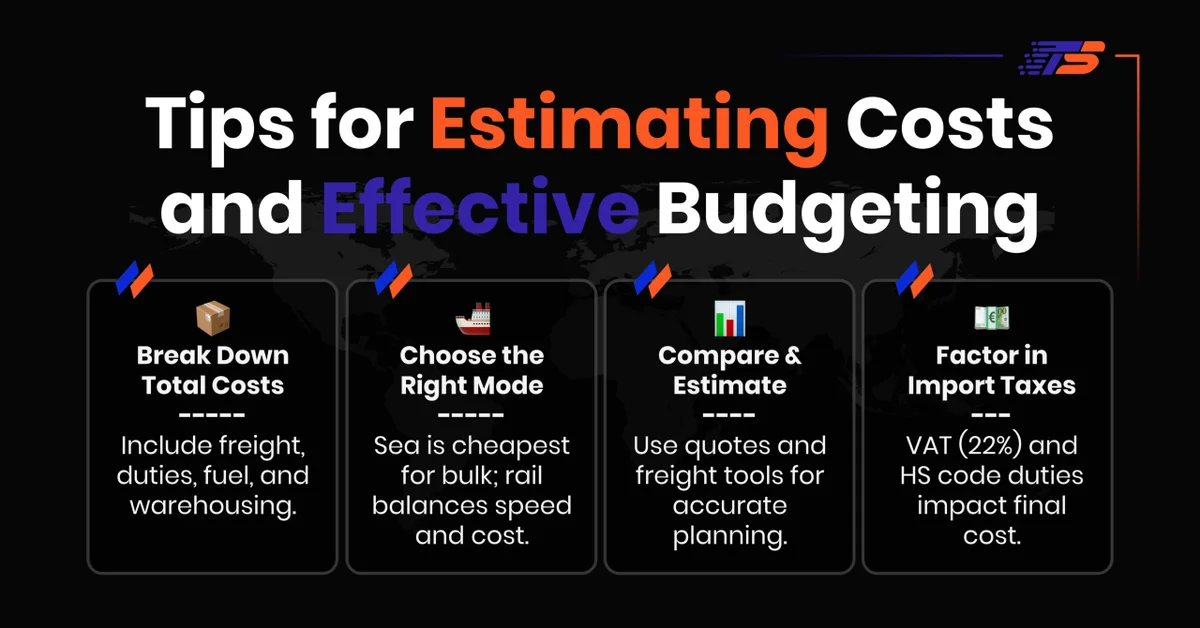
Shipping Costs & Transparent Pricing
Say goodbye to unexpected shipping costs! With TopShipping, your shipments from China to Italy are fully transparent from start to finish. Our all-in-one pricing includes freight, Italian customs duties, VAT, port handling, and final delivery—so you never face hidden charges.
From large FCL shipments to small LCL parcels or eCommerce orders, we give you a clear cost breakdown, allowing you to plan smarter, save on surprises, and ensure your goods reach Italy on time, every time.
| Service Type | Cost Range | Minimum Charge | Best For | Estimated Transit Time (Door-to-Door) |
|---|---|---|---|---|
| Express Courier (DHL/UPS/FedEx) | $28 – $50 per kg | $60 | Urgent parcels, samples, documents, eCommerce orders | 3 – 6 days |
| Air Freight (Standard) | $4 – $9 per kg | $70 | Medium-weight shipments, moderately urgent cargo | 6 – 10 days |
| Sea Freight (LCL) | $90 – $170 per CBM | 1 CBM | Small to medium shipments (non-containerized) | 25 – 35 days |
| Sea Freight (FCL) – 20ft | $1,100 – $2,200 | Full container | Bulk shipments, exclusive container use | 22 – 30 days |
| Sea Freight (FCL) – 40ft | $1,600 – $3,200 | Full container | Large-volume cargo, cost-efficient | 22 – 30 days |
| Rail Freight (LCL) | $200 – $270 per CBM | 1 CBM average | Eco-friendly smaller shipments to Italy | 18 – 25 days |
| Rail Freight (FCL) – 40ft HQ | $8,000 – $9,200 | Full container | Time-sensitive or high-value shipments inland | 16 – 22 days |
Factors Affecting Shipping Costs from China to Italy
- Shipping Method: Sea, air, rail, or express—each has different rates and speed.
- Cargo Size & Weight: Larger or heavier shipments cost more; LCL vs FCL affects pricing.
- Distance & Route: Transit routes, port locations, and inland transportation add to costs.
- Customs Duties & Taxes: VAT, import duties, and clearance fees impact total expenses.
- Season & Peak Demand: Holidays or high-demand periods can increase freight rates.
- Packaging & Handling: Special packing, fragile goods, or oversized cargo may incur extra charges.
- Insurance: High-value shipments require insurance, adding to overall cost.
By taking these factors into account early, importers can plan more precise budgets, minimize unforeseen costs, and select the most cost effective and timely shipping solution for their business.

Customs, Duties & Insurance Guide
Importing goods from China to Italy can be challenging, but professional customs management makes the process seamless. We handle all documentation, Italian customs duties, VAT, and inspections to ensure quick clearance at major ports like Genoa, Milan, and La Spezia. With careful planning, your shipments arrive on time, efficiently, and without unexpected delays.
Common Import Duty Examples for Italy
| Product Category | HS Code Range | Typical Duty Rate | Notes / Tips for Importers |
|---|---|---|---|
| Electronics (smartphones, laptops, tablets) | 85xx | 0% – 14% | Many electronics require CE marking and must comply with EU directives. Verify compliance with RoHS and WEEE regulations. |
| Textiles & Apparel (clothing, fabrics) | 50xx – 63xx | 12% – 17% | Duty varies by fabric type and origin. Check for anti-dumping duties on some Chinese fabrics. |
| Furniture (wood, metal, plastic) | 94xx | 5% – 12% | Ensure proper packing, labeling, and compliance with EU safety and chemical regulations (REACH). |
| Toys & Games | 95xx | 0% – 14% | Battery-operated or electronic toys require CE marking and EN71 certification for safety. |
| Footwear (leather, rubber, synthetic) | 64xx | 8% – 17% | Duty varies by material; check EU quality and labeling standards. |
| Machinery & Mechanical Appliances | 84xx – 85xx | 0% – 9% | Ensure CE marking and compliance with EU machinery directives. |
| Pharmaceuticals & Chemicals | 30xx – 38xx | 0% – 6.5% | Some products need EMA approval or specific licenses for import. |
| Solar Panels & Renewable Energy Equipment | 85xx – 90xx | 5% – 14% | Subject to EU regulations and certifications; check for anti-dumping or safeguard measures. |
Italy Customs & Import Documentation Requirements
| Document Type | Required For | Purpose / Notes |
|---|---|---|
| Commercial Invoice | All imports | Declares the goods’ value for calculating import duties and Italian VAT. Must be accurate to avoid fines or delays. |
| Packing List | All shipments | Detailed list of cargo for inspection, classification, and verification. Helps Italian Customs verify contents quickly. |
| Bill of Lading / Air Waybill (AWB) | Sea, air, and rail freight | Serves as proof of shipment and contract of carriage between shipper and carrier. |
| Certificate of Origin | Goods eligible for preferential duty rates | Confirms the country of origin to claim benefits under trade agreements (e.g., EU-China trade agreements). |
| Import Declaration (Italian Customs / AIDA / SDI) | All commercial cargo | Mandatory for clearance through Italian Customs. Filed electronically for faster processing. |
| Compliance Certificates / Licenses | Electronics, machinery, medical devices, chemicals, food products | Ensures compliance with CE marking, EU regulations, or other Italian/EU standards. Required to avoid shipment rejection. |
| EORI Number | All commercial imports | EU-wide registration and identification number for importers/exporters required for customs clearance. |
| Intrastat Declaration | Imports above threshold | Statistical declaration for goods entering Italy from non-EU countries. Helps track trade volumes. |
Customs Clearance Tips for Shipping to Italy
Efficient customs clearance is essential when importing goods from China to Italy. Proper preparation ensures faster delivery, minimizes unexpected costs, and avoids unnecessary delays.
Here’s how to streamline the process:
- Accurate Documentation: Ensure invoices, packing lists, and bills of lading/airway bills are complete.
- Correct HS Codes: Classify products properly to apply the right duties and VAT.
- Duties & Taxes: Pay or pre-calculate customs duties and VAT to avoid holds.
- Product Regulations: Electronics, machinery, chemicals, and restricted items need permits/certifications.
- Experienced Freight Forwarders: Use partners familiar with Italian customs to reduce errors and speed clearance.
- Plan for Peak Seasons: Ship early to avoid delays during holidays or high-volume periods.
When these steps are followed, most shipments clear Italian customs smoothly, allowing your products to reach their destination on time and without stress.
Italy Customs & Import Guide for B2B Imports from China
Shipping from China to Italy requires understanding customs rules to avoid delays.
- Duties & VAT: Import duties vary by HS code (0–17%), and Italian VAT is generally 22%.
- Mandatory Documentation: Commercial invoice, packing list, Bill of Lading / Air Waybill (AWB) , and EORI number are required.
- Special Products: Electronics, chemicals, food, and medical devices may need CE marking or additional licenses.
- Compliance & Planning: Accurate paperwork and using a trusted freight forwarder help speed up clearance and ensure on-time delivery.
By keeping these essentials in mind, your shipments can pass Italian customs smoothly, stay compliant, and arrive at your warehouse promptly without unexpected delays or extra costs.
Customs Clearance Methods & Incoterms for Shipping China to Italy
| Incoterm | Seller’s Responsibility | Buyer’s Responsibility | Best For / Notes | Approx. Transit Time (China → Major Italian Ports) | Estimated Cost Responsibility |
|---|---|---|---|---|---|
| DDP Incoterm (Delivered Duty Paid) | Full shipping, insurance, Italian customs duties, VAT, and delivery to buyer’s warehouse or doorstep | Simply receive goods | First-time importers or those wanting hassle-free, door-to-door delivery | 25–40 days (sea) / 5–12 days (air) | Seller covers freight, insurance, customs duties, VAT, port handling, and final delivery |
| DAP incoterm(Delivered At Place) | Delivery to agreed Italian port (e.g., Genoa, Milan, Trieste) | Customs clearance, duties, VAT, and inland transport | Experienced importers handling local customs clearance | 20–35 days (sea) / 5–10 days (air) | Buyer pays import duties, VAT, and inland transport costs |
| CIF incoterm (Cost, Insurance, Freight) | Shipping & insurance to Italian port | Customs clearance, duties, VAT, and inland delivery | Port-to-port shipments requiring insurance coverage | 20–35 days (sea) / 5–10 days (air) | Seller pays freight & insurance; buyer handles customs duties, VAT, and inland transport |
| FOB Incoterm (Free On Board) | Goods loaded onto vessel at Chinese port | International freight, customs, VAT, and delivery | Importers managing their own shipping and logistics | Depends on chosen freight mode | Buyer pays all costs from port of loading onwards (freight, insurance, customs, VAT, delivery) |
Customs Success Tips for Shipping Italy
To get your goods to Italy on time, make sure all shipment details are precise—use correct product descriptions, accurate HS codes, and complete paperwork like invoices and packing lists.
Collaborating with a reliable customs specialist can simplify handling duties and VAT, speeding up clearance and ensuring your cargo arrives safely.
With proper preparation, your shipments reach Italy efficiently, keeping your business running without interruptions.
Prohibited and Restricted Items
Before shipping to Italy, it’s important to understand the country’s import rules. Some products are strictly prohibited, while others are allowed only with the right permits or certificates. Having a clear idea of these categories helps you avoid delays, extra costs, or even the risk of your goods being rejected at customs.
To make things clearer, we’ve prepared a detailed table where you can easily review the prohibited and restricted products before planning your shipment.
| Category | Prohibited Items | Restricted / Conditional Items |
|---|---|---|
| Dangerous Goods & Weapons | Firearms, ammunition, explosives, hunting knives, swords | – |
| Endangered Species & Cultural Artifacts | Ivory, exotic animal skins, protected wildlife items | Artifacts, antiques – require import permit from the Ministry of Culture |
| Food, Alcohol & Agricultural Products | – | Meat, dairy, live plants, up to 20 kg fish – require health & phytosanitary certificates |
| Cosmetics & Personal Care | – | Demand CE marking, regulatory compliance, sanitary approval |
| Medical Devices & Pharmaceuticals | – | Must be CE-marked and registered with Italian Ministry of Health database |
| Currency | – | Amounts above €10,000 must be declared to customs |
Key Ports in China and Italy for Shipping
Major Origin Ports & Cities in China for Italy Shipments
- Shanghai (SHACN): China’s largest container port, ideal for high-volume cargo to northern and central Italian ports.
- Shenzhen/Yantian (SZXCN): Electronics, fashion, and consumer goods hub with strong sea and air freight options to Italy.
- Guangzhou (CANCN): Manufacturing powerhouse, offering flexible sea-air combinations for urgent shipments.
- Ningbo (NGBCN): Cost-efficient alternative to Shanghai for both LCL (Less than Container Load) and FCL (Full Container Load) container shipments.
- Qingdao (TAOCN): Reliable northern port for industrial goods and bulk shipments to Italy.
Major Destination Ports in Italy
- Genoa (ITGOA): Italy’s busiest port in the north, serving industrial and consumer markets efficiently.
- La Spezia (ITLSP): Strategic hub for central Italy, ideal for machinery, textiles, and automotive imports.
- Trieste (ITTRS): Key northern gateway for Eastern Europe access and bulk cargo handling.
- Naples (ITNAP): Southern Italy’s primary port, excellent for food, consumer goods, and industrial shipments.
- Civitavecchia (ITCVR): Port for Rome and central Italy, supporting fast distribution of high-value imports.
Smart route planning combined with experienced logistics partners ensures your goods move from China to Italy smoothly, arrive on time, and reach your business ready for market.
Major Air Freight Hubs for China to Italy Shipments
Key Airports in China:
- Shanghai Pudong International Airport (PVG): China’s busiest cargo hub, perfect for electronics, textiles, and general merchandise with frequent flights to Italy.
- Guangzhou Baiyun International Airport (CAN): Southern China’s strategic gateway, ideal for automotive parts, consumer goods, and industrial machinery.
- Shenzhen Bao’an International Airport (SZX): Main hub for high-tech electronics, fashion items, and urgent shipments, offering fast customs clearance.
- Beijing Capital International Airport (PEK): Northern hub for samples, medical equipment, and time-sensitive cargo.
- Ningbo Lishe International Airport (NGB): Growing hub for industrial and consumer goods, offering cost-effective air cargo options.
Major Airports in Italy:
- Milan Malpensa Airport (MXP): Italy’s largest air cargo hub, serving northern and central industrial regions efficiently.
- Rome Fiumicino Airport (FCO): Strategic gateway for central Italy, ideal for high-value goods, fashion, and electronics.
- Bologna Guglielmo Marconi Airport (BLQ): Northern Italy hub supporting machinery, textiles, and perishable cargo.
- Venice Marco Polo Airport (VCE): Convenient for northeast Italy and nearby European markets, especially for light industrial and consumer shipments.
- Naples International Airport (NAP): Southern Italy hub for eCommerce, food, and light industrial imports.
Smart Shipping Routes & Airport Selection for Italy
Pick key gateways like Milan Malpensa (MXP) or Rome Fiumicino (FCO) for faster customs clearance and stronger global air cargo connections.
For region-specific deliveries, rely on Venice (VCE) in the north or Naples (NAP) in the south to minimize inland trucking and reach your customers quicker.
Match your airport choice with the type of cargo and final destination whether it’s fashion, machinery, or perishable goods to cut logistics costs, speed up transit, and ensure safe, reliable handling every time.
Shipping Platforms & Freight Partners for China-to-Italy Trade
Move your cargo from China to Italy with ease through dependable carriers and experienced logistics providers. Whether it’s fast air freight to Milan, Rome, or Bologna, or cost-effective sea freight to major ports like Genoa, Venice, or Trieste, you can choose the option that best matches your timeline, cargo size, and budget.
With reliable tracking, clear communication, and dedicated support, your goods will clear customs smoothly and arrive safely, on schedule, and without unnecessary stress so you can keep your business moving forward.
Leading Express & Courier Solutions from China to Italy
DHL Express – Speed with Maximum Reliability
- Transit Time: 3–5 working days with full online tracking.
- Coverage: Direct delivery to major hubs like Rome, Milan, Turin, Naples, Florence, and other key regions.
- Best For: Urgent shipments, valuable products, or temperature-sensitive cargo requiring priority handling.
- TopShipping Insight: Best option when timing is critical and delays are not an option.
FedEx Express – Strong Customs Support & Global Access
- Transit Time: 4–6 working days with efficient customs clearance across Italian ports and airports.
- Coverage: Ideal for e-commerce orders, business samples, and essential documents delivered to both metropolitan and regional areas.
- Best For: Small and medium businesses looking for affordable yet reliable express delivery.
- TopShipping Insight: A smart solution for regular shipments where consistency and customs expertise matter.
UPS Express – Tailored for Bulk and B2B Shipments
- Transit Time: 4–6 working days supported by advanced ground logistics across Italy.
- Coverage: Specializes in handling larger consignments, Amazon FBA fulfillment, and B2B freight deliveries.
- Best For: Exporters with frequent, high-volume shipments who need dependable schedules.
- TopShipping Insight: Perfect choice for businesses managing strict deadlines and heavy consignments.
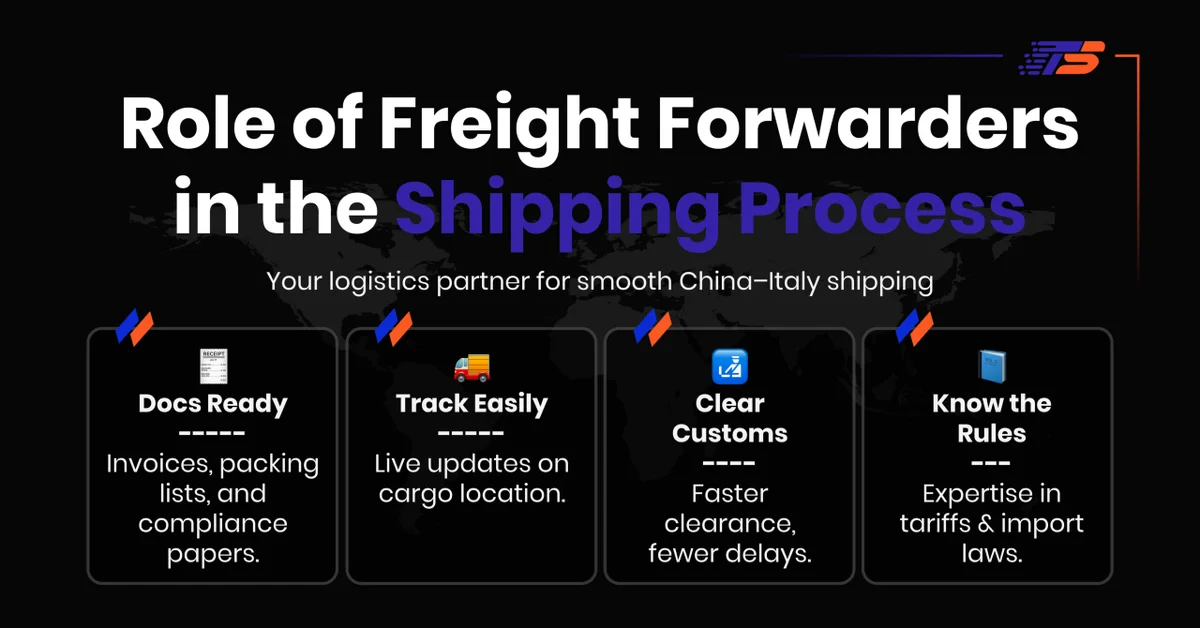
International Freight Forwarder from China to Italy
Move your cargo from China to Italy effortlessly with TopShipping, your reliable international freight forwarder . We manage every step—from pickup at Chinese factories to delivery at your warehouse or doorstep in Milan, Rome, or Turin.
Choose sea, air, or rail freight with confidence, backed by transparent pricing, secure handling, and smooth customs clearance. Simplify your global logistics and ship smarter with TopShipping.
How to Choose the Right Freight Forwarder for Italy?
Selecting the right freight partner is crucial for smooth, efficient shipments. Focus on:
- Experience & Expertise: Ensure they have a proven track record on China–Italy routes.
- Strong Network: Reliable partners and agents in both countries for seamless operations.
- Range of Services: Warehousing, consolidation, and last-mile delivery options.
- Customs Knowledge: Familiarity with Italian import regulations to avoid delays.
- Transparent Pricing: Clear, all-inclusive costs with no hidden fees.
- Cargo Handling: Proper packaging and handling for fragile, bulky, or high-value goods.
- Customer Support: Responsive team available for real-time updates and problem-solving.
- Technology & Tracking: Advanced shipment tracking for visibility and peace of mind.
Choosing a forwarder with these qualities ensures smooth customs clearance, timely deliveries, and a stress-free supply chain.
Shipping Made Simple: From China to Italy in Easy Steps
Planning to ship goods from China to Italy? The key to hassle-free delivery lies in preparation. Proper documentation, sturdy packaging, and clear labeling can make all the difference in avoiding delays and ensuring your cargo arrives safely. Here’s your step-by-step checklist to get it right:
1-Accurate Documentation:
- Prepare commercial invoices, packing lists, and bills of lading.
- Ensure all details (product description, value, quantity) are correct to avoid customs delays.
2-Secure Packaging:
- Use strong, durable materials to protect goods during transit.
- Follow international shipping standards for sea, air, or rail transport.
3-Clear Labeling:
- Label each package with contents, handling instructions, and destination details.
- Ensure compliance with both Chinese and Italian customs regulations.
4-Special Handling for Sensitive Items:
- Use anti-static, temperature-controlled, or shock-proof packaging if required.
- Clearly indicate any fragile or high-value items to ensure careful handling.
5-Consolidation (Optional):
Group smaller shipments efficiently to save costs and simplify customs clearance.
6-Customs Compliance:
Verify that restricted or regulated items have the necessary permits or certificates.
Final Review
Efficient shipping from China to Italy relies on making smart, informed decisions. By balancing speed, cost, and reliability, choosing the right transport mode, and understanding Shipping Incoterms , you can ensure your goods arrive on time, compliant, and hassle-free. Partnering with experienced logistics providers, planning ahead for seasonal peaks, and streamlining customs processes makes China–Italy shipments more predictable, smooth, and cost-effective.
FAQs: Shipping to Italy
Which routes are used for Truck Transportation?
Truck shipments typically travel through the China–Central Asia–Europe corridor, crossing countries like Kazakhstan, Russia, and Eastern Europe, before reaching Italy. These are well-established overland shipping routes connecting major logistics hubs.
Is Road Freight possible from China to Italy?
Yes, road freight using trucks is possible, but it is usually part of a multimodal transport solution rather than direct trucking, due to the long distance and multiple countries between China and Italy.
How much does it cost to ship from China to Italy?
Costs vary by shipment size, weight, and shipping method; sea freight is cheapest for bulk, air freight is faster but more expensive.
How much will it cost to ship a package to Italy?
Small parcels via express services can range from $25–$50 per kg, depending on carrier and delivery speed.
What is the import duty from China to Italy?
Import duties usually range from 0–25% depending on the product category and HS code.
Why is shipping to Italy so expensive?
High costs can result from express services, customs clearance, handling fees, and peak-season surcharges.
How long is the ship from China to Italy?
Sea freight typically takes 20–35 days from major Chinese ports to Italian ports.
How long does it take to ship from China to Italy?
Air freight takes 5–10 days, while sea freight can take 20–35 days depending on route and port congestion.
